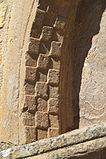Santa María (Tábara)
The Catholic parish church of Santa María (also Nuestra Señora de la Asunción) in Tábara is 44 km northwest of Zamora , the capital of the province of the same name in the Spanish autonomous region of Castile and León . The church dedicated to the Assumption of Mary originally belonged to a monastery founded towards the end of the 9th century, whose scriptorium became famous for its manuscripts decorated with book illuminations . In the substructure of the bell tower, wall remnants from pre-Romanesque times have been preserved. In 1931 the church was declared a monument ( Bien de Interés Cultural ).
history
At the end of the 9th century, the two monks Froilán (833–904), who later became Bishop of León , and Attila (around 850– after 920), who later became Bishop of Zamora , founded the San Salvador Monastery in Tábara , which was consecrated to Salvator mundi . After the reconquest of the areas north of the Duero , the Asturian King Alfons III promoted. (866-910) the repopulation of these areas, whereby the founding of monasteries played an important role. Froilán has received a copy of his biography from 920, in which the founding of the monastery is mentioned. Obviously it was a double monastery , as more than six hundred monks and nuns are said to have settled there soon, according to the Vita Sancti Froilani .
At the end of the 10th century, the monastery was probably destroyed during the Almansor campaigns . At the beginning of the 12th century the tower and the church were rebuilt in the Romanesque style. In 1137 another consecration took place by the Bishop of Astorga . In the 12th century the church passed into the possession of the Knights Templar on a date that cannot be precisely determined . In the second half of the 18th century the church was redesigned in the Baroque style.
Beatus of Tábara
In the scriptorium of the monastery of Tábara, a manuscript with book illumination was created in the 10th century , the so-called Beatus of Tábara , a copy of the commentary on the Revelation of John named after the monk Beatus of Liébana . Most of the miniatures were made by the monk Magius / Maius, who had completed the so-called Morgan Beatus in the monastery of San Miguel de Escalada . After his death in 968, the Tábara manuscript was completed by Emeterius, a student of Magius. It is written in Visigothic script and has annotations in Arabic around the edges . On the last page you can find the representation of the bell tower of the former monastery church. Its walls are pierced by horseshoe-shaped openings and the floors are connected by ladders. Below is a monk who rings the bells with two ropes. To the right of the tower there are rooms, in the scriptorium - the depiction is considered to be the oldest picture of a scriptorium in European art - Emeterius and a monk named Senior sit across from each other, in another room another monk is cutting parchments . In the colophon of the manuscript, Emeterius expresses himself - with the exact date - relieved that his work has been completed: “Oh tower of Tábara, you high stone tower! Here, in the top and first room of the library, Emeterius sat hunched over his task for three months, his muscles exhausted from working with the pen when he was in the eighth hour of this on the sixth day before the calendar of August in the year 1008 Book finished. "
The Spanish era Era is 38 years before the Christian one, from the manuscript 26 July 970 results as the date of completion of our era. Tábara's Beatus manuscript is now kept in the Archivo Histórico Nacional in Madrid .
architecture
The bell tower rises on the west facade, the substructure of which is traced back to Mozarabic origins, as evidenced by the multiple tiered horseshoe- arched access from the nave to the tower chamber. In this chamber capitals and other evidence of early medieval sculptures are exhibited today . The three upper floors of the tower date from the Romanesque period and are pierced by arched sound arcades .
Two arched portals, a north and a south portal, open to the church. The south portal is framed by two archivolts , the outer one is decorated with a chessboard frieze. Of the two columns, only the right one, which has a leaf capital, is preserved.
literature
- Achim Arbeiter , Sabine Noack-Haley: Christian monuments of the early Middle Ages from the 8th to the 11th century . Mainz 1999, ISBN 3-8053-2312-3 , pp. 255-258.
- Jaime Cobreros: Guía del Prerrománico en España . Madrid 2006, ISBN 84-9776-215-0 , pp. 170-171.
- Rubén Fernández Mateos: Todo el Románico de Zamora . Fundación Santa María la Real , Centro de Estudios del Románico. Aguilar del Campoo 2010, ISBN 978-84-89483-66-8 , pp. 170-172.
Web links
- Tábara arteguias (Spanish, accessed May 30, 2016)
Individual evidence
- ↑ Portal de archivos españoles Beatus von Tábara (Spanish, accessed May 30, 2016)
Coordinates: 41 ° 49 ′ 36 " N , 5 ° 57 ′ 29" W.






